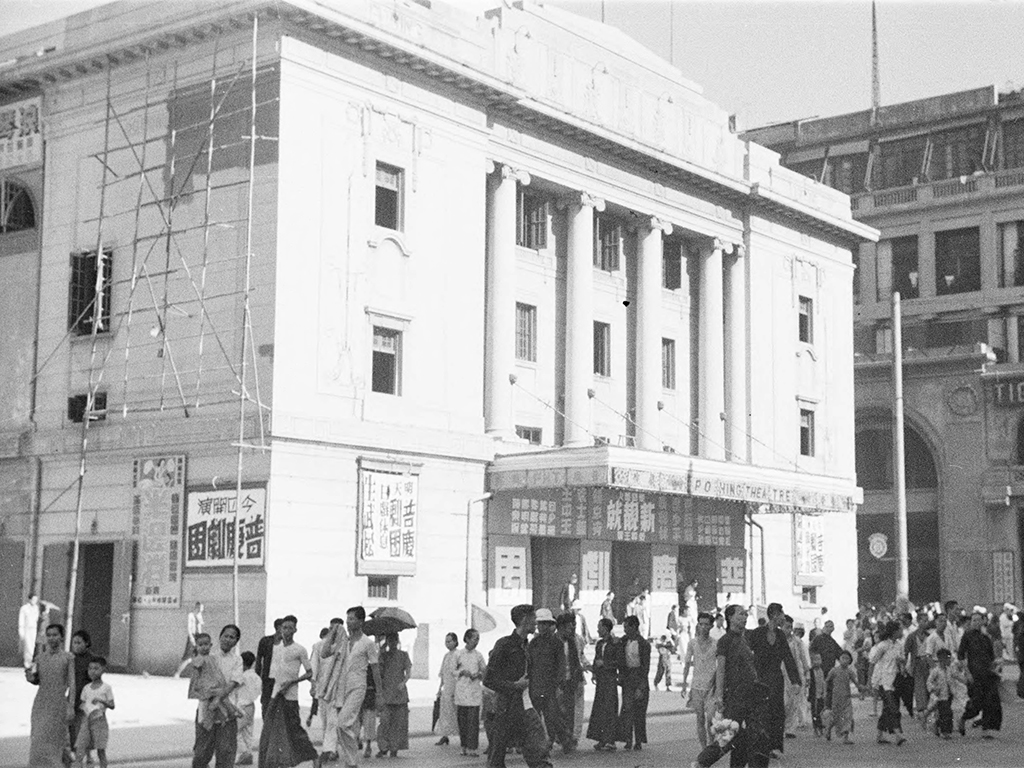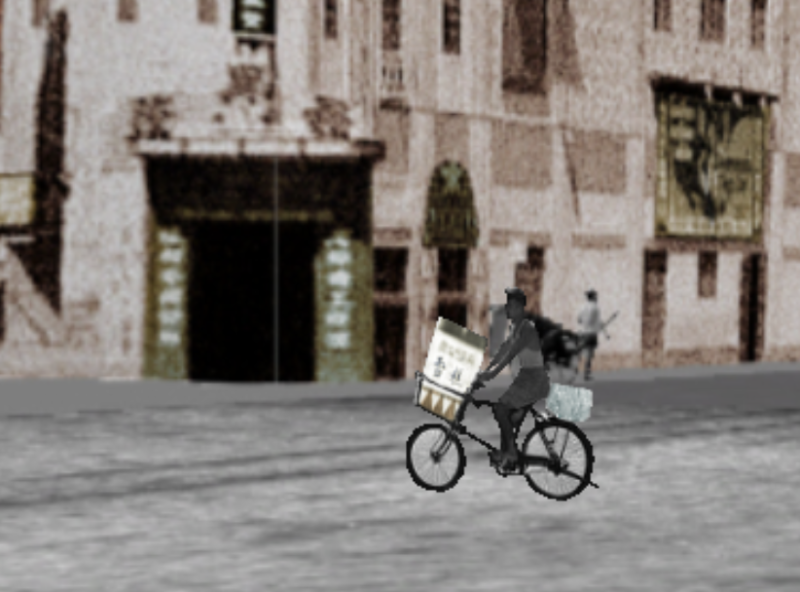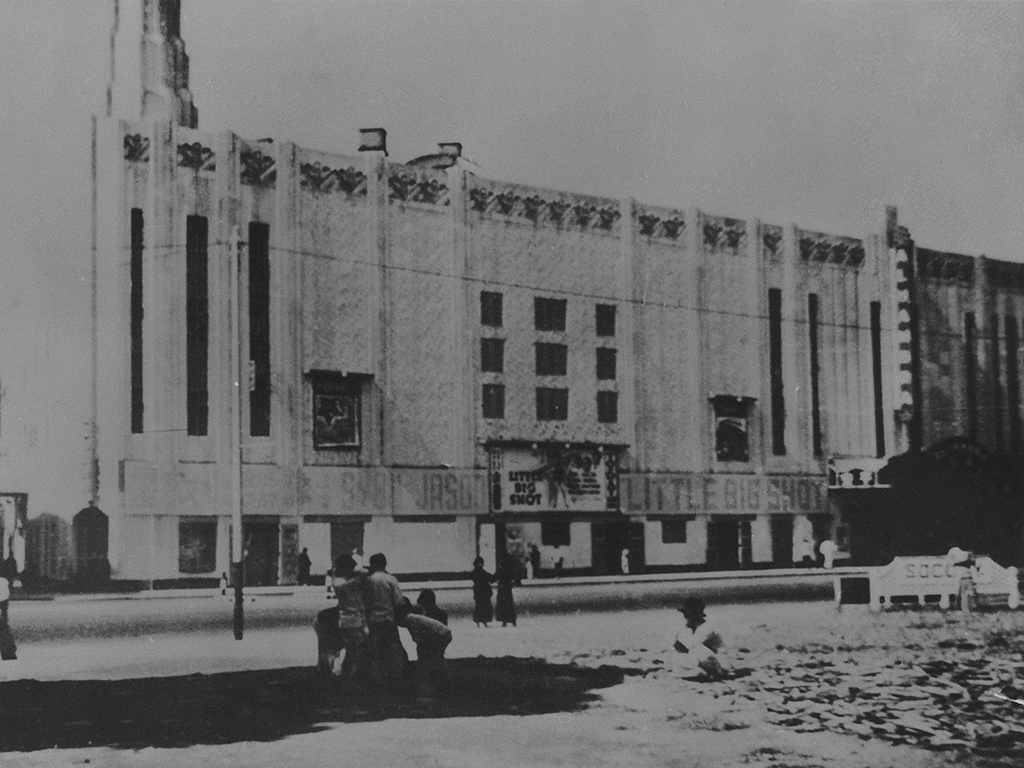YAU MA TEI – Nathan Road ca.1950

360-degree panoramic artwork developed from historical photos
Historical Hotspots:
Alhambra Theatre
Opened in 1934, the Alhambra Theatre was one of the earliest movie houses constructed with soundproofing materials in southern China. Vertically, it was built in a trapezoid shape and joined by a curved roof supported by a widely spanned steel framework. In its fan-shaped auditorium, configured with private boxes and balcony seats upstairs, more than one thousand seats were provided on the ground floor. The theatre emphasised on modern minimalism, as the windows’ patterns and streamers were featured with Art Deco design. At the entrance, there was a neon light billboard advertising the theatre’s name above the huge canopy at the height of 18 feet. As one of the biggest cinemas in Hong Kong, its business came to an end after 24 years, and it was redeveloped into the Alhambra Building in 1960.
Under the operation of the same company, the Alhambra Theatre and the Queen’s Theatre screened western movies jointly with the same ticket prices. The Alhambra Theatre offered special promotions, including a ferry fare waiver or a vehicular ferry waiver for the moviegoers who needed to commute across Victoria Harbour from Hong Kong Island. They could also travel to the theatre from Tsim Sha Tsui or Jordan Road by bus at a discounted fare. The first movie screening at the Alhambra Theatre was Gold Diggers of 1933 , produced in the United States. Sound films had also been available at the Alhambra Theatre since 1935. On 20 March 1954, Women of Paris, the first movie with English subtitles in Hong Kong, was screened at the Alhambra Theatre and the Queen’s Theatre concurrently.
Photo courtesy of Government Photo Store, Information Services Department
Po Hing Theatre

Opened for business in 1902, Po Hing Theatre was one of the oldest cinemas in Kowloon. It was initially a traditional Chinese theatre, which hosted live performances of Cantonese operas. This two-storey building underwent demolition and renovation since its roof tiles were blown off by strong winds in 1927. The second-generation Po Hing Theatre featured a splendid platform setting in a western style. The redeveloped theatre screened movies occasionally. In 1955, the whole building was redeveloped as the Astor Building and housed a department store, while the theatre installed with the largest screen on Hong Kong Island and in Kowloon at that time was integrated into the rear block. In 1990, the complex was converted into the Eaton Hotel Hong Kong and Astor Plaza. The theatre then became a mini movie house in the shopping mall until 2002.
As a classical revival architecture, the three-columned structure of classicalism was represented on the second-generation Po Hing Theatre’s external wall: 6 two-storey-tall Ionic pillars were centrally erected at the entrance showing a grandiose and magnificent appearance. The wall could also be used to prop up the gigantic flower plaques to celebrate grand shows and festival events. In 1953, a flower plaque was lifted and held for the coronation of Queen Elizabeth II.
Photo courtesy of the American Geographical Society Library, University of Wisconsin- Milwaukee Libraries
Kowloon Magistracy (South Kowloon District Court)

Built in 1936, the South Kowloon District Court was initially named Kowloon Magistracy, specifically responsible for minor criminal cases such as illegal hawking. It was renamed as South Kowloon District Court in 1961. In 1986, it was converted to the Judiciary Central File Repository, and it served as the office of the Lands Tribunal and Labour Tribunal after 1997. The building reflected the style of classical revival with its majestic and solemn architectural design. The base of the front side of Gascoigne Road was composed of granite rock, and there was a corridor sided with Ionic granite pillars above this solid foundation, which looked grand and solemn. The Magistracy was declared a Grade I historic building in 2009.
On 25 December 1941, the defeat of the British forces stationed in Hong Kong marked the moment when the Japanese forces began their occupation of the city. The magistracy building was confiscated as a Japanese army’s office, and it resumed its original function after the end of World War II. At that time, the government had provisionally increased magistrates’ power to sentence the offenders at a maximum from 12 months to 2 years. If the offenders were convicted of more than one crime, then the maximum penalty could be up to 3 years. This provisional practice was made into a permanent enactment in 1949. The magistrates were also entitled to assign fine penalties for minor offences.
Photo courtesy of Government Photo Store, Information Services Department
Animation:

Bustling with cinemas, Yau Ma Tei was a busy and crowded hotspot for various street food hawkers to run their businesses. Ice cream vendors often came over with their bikes refitted with a cooler box full of ice cream. After the vendors stationed their bikes in front of cinemas, they would then begin selling ice cream to the mass of moviegoers.
